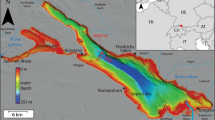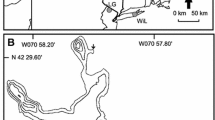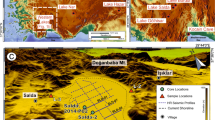Abstract
J.L. Hough in 1962 recognized an erosional unconformity in the upper section of early postglacial lake sediments in northwestern Lake Huron. Low-level Lake Stanley was defined at 70 m below present water surface on the basis of this observation, and was inferred to follow the Main Algonquin highstand and Post-Algonquin lake phases about 10 14C ka, a seminal contribution to the understanding of Great Lakes history. Lake Stanley was thought to have overflowed from the Huron basin through the Georgian Bay basin and the glacio-isostatically depressed North Bay outlet to Ottawa and St. Lawrence rivers. For this overflow to have occurred, Hough assumed that post-Algonquin glacial rebound was delayed until after the Lake Stanley phase.
A re-examination of sediment stratigraphy in northwestern Lake Huron using seismic reflection and new core data corroborates the sedimentological evidence of Hough’s Stanley unconformity, but not its inferred chronology or the level of the associated lowstand. Erosion of previously deposited sediment, causing the gap in the sediment sequence down to 70 m present depth, is attributed to wave erosion in the shoreface of the Lake Stanley lowstand. Allowing for non-deposition of muddy sediment in the upper 20 m approximately of water depth as occurs in the present Great Lakes, the inferred water level of the Stanley lowstand is repositioned at 50 m below present in northwestern Lake Huron. The age of this lowstand is about 7.9 ± 0.314C ka, determined from the inferred 14C age of the unconformity by radiocarbon-dated geomagnetic secular variation in six new cores. This relatively young age shows that the lowstand defined by Hough’s Stanley unconformity is the late Lake Stanley phase of the northern Huron basin, youngest of three lowstands following the Algonquin lake phases. Reconstruction of uplift histories for lake level and outlets shows that late Lake Stanley was about 25–30 m below the North Bay outlet, and about 10 m below the sill of the Huron basin. The late Stanley lowstand was hydrologically closed, consistent with independent evidence for dry regional climate at this time. A similar analysis of the Chippewa unconformity shows that the Lake Michigan basin also hosted a hydrologically closed lowstand, late Lake Chippewa. This phase of closed lowstands is new to the geological history of the Great Lakes.








Similar content being viewed by others
References
Anderson TW, Lewis CFM (2002) Upper Great Lakes climate and water-level changes 11 to 7 ka: effect on the Sheguiandah archeological site. Chapter 8. In: Julig PJ (ed) The Sheguiandah Site—Archaeological, Geological and Paleobotanical studies at a Paleoindian Site on Manitoulin Island, Ontario. Canadian Museum of Civilization, Mercury Series, Archaeol Surv of Can Paper 161, pp 195–234
Andrews JT (1970) A Geomorphological Study of Postglacial Uplift with particular reference to Arctic Canada. Institute of British Geographers Spec Pub 2:156
Baker RG, Maher LJ, Chumbley CA,Van Zant KL (1992) Patterns of Holocene environmental change in the midwestern United States. Quat Res 37:379–389
Barnett PJ (1992) Quaternary geology of Ontario. In Thurston PC, Williams HR, Sutcliffe RH, Scott GM (eds), Geology of Ontario. Ont Geol Surv Spec Vol 4, Part 2, pp 1011–1088
Bengtsson L, Malm J (1997) Using rainfall-runoff modeling to interpret lake level. J Paleolimnol 18:235–248
Blasco SM (2001) Geological history of Fathom Five National Marine Park over the past 15000 years. In: Parker S, Munawar M (eds) Ecology, culture and conservation of a protected area: Fathom Five National Marine Park, Canada. Ecovision Monograph Series, Backhuys Publishers, Leiden, pp 45–62
Bryson RA, Wendlund WM (1967) Tentative climatic patterns for some late-glacial and postglacial episodes in central North America. In: Mayer-Oakes WJ (ed) Life, land and water. University of Manitoba Press, Winnipeg, pp 271–298
Colman SM, Clark JA, Clayton L, Hansel AK, Larsen CE (1994a) Deglaciation, lake levels, and meltwater discharge in the Lake Michigan basin. Quat Sci Rev 13:879–890
Colman SM, Forester RM, Reynolds RL, Sweetkind DS, King JW, Gangemi P, Jones GA, Keigwin LD, Foster DS (1994b) Lake-level history of Lake Michigan for the past 12,000 years: the record from deep lacustrine sediments. J Great Lakes Res 20:73–92
Cowan WR (1985) Deglacial shorelines at Sault Ste. Marie. In: Karrow PF, Calkin PE (eds) Quaternary Evolution of the Great Lakes. Geol Assoc of Can Special Paper 30, pp 33–37
Crane HR, Griffin JB (1965) University of Michigan radiocarbon dates X. Radiocarbon 7:123–152
Crane HR, Griffin JB (1968) University of Michigan radiocarbon dates XII. Radiocarbon 10:61–114
Crane HR, Griffin JB (1970) University of Michigan radiocarbon dates XIII. Radiocarbon 12:161–180
Croley III TE, Quinn FH, Kunkel KE, Changon SA (1996) Climate transposition effects on the Great Lakes hydrological cycle. NOAA Tech. Memo. ERL-GLERL-89, Great Lakes Environmental Research Laboratory, Ann Arbor, p 100
Dean WE, Ahlbrandt TS, Anderson RY, Bradbury JP (1996) Regional aridity in North America during the middle Holocene. The Holocene 6:145–155
Dobson DM, Moore Jr. TC, Rea DK (1995) The sedimentation history of Lake Huron and Georgian Bay: results from analysis of seismic reflection profiles. J Paleolimnol 13:231–249
Dyke AS, Moore A, Robertson L (2003) Deglaciation of North America. Geol Surv Can Open File 1574. Geol Surv of Can, Ottawa, ON, CD-ROM
Edwards TWD, Wolfe BB, MacDonald GM (1996) Influence of changing atmospheric circulation on precipitation δ18O—temperature relations in Canada during the Holocene. Quat Res 46:211–218
Eschman DF, Karrow PF (1985) Huron basin glacial lakes: a review. In: Karrow PF, Calkin PE (eds) Quaternary evolution of the Great Lakes. Geol Assoc of Can Spec Paper 30, pp 79–93
Farrand WR, Drexler CW (1985) Late Wisconsinan and Holocene history of the Lake Superior basin. In: Karrow PF, Calkin PE (eds) Quaternary Evolution of the Great Lakes. Geol Assoc of Can Spec Paper 30, pp 17–32
Ford MJ, Geddes RS (1986) Quaternary geology of the Algonquin Park area. Ont Geol Surv Open File Report 5600, p 87
Forester RM, Colman SM, Reynolds RL, Keigwin LD (1994) Lake Michigan’s late Quaternary limnological and climate history from ostracode, oxygen isotope, and magnetic susceptibility. J Great Lakes Res 20:93–107
Hansel AK, Mickelson DM, Schneider AF, Larsen CE (1985) Late Wisconsinan and Holocene history of the Lake Michigan basin. In: Karrow PF, Calkin PE (eds) Quaternary Evolution of the Great Lakes. Geol Assoc of Can. Spec Paper 30, pp 39–53
Harrison JE (1970) Deglaciation and proglacial drainage: North Bay-Mattawa region, Ontario. In: Proceedings 13th Conference on Great Lakes Research, Int Assoc of Great Lakes Res. Buffalo, NY, pp 756–767
Harrison JE (1972) Quaternary geology of the North Bay-Mattawa region. Geol Surv Can Paper 71–26:37
Holcombe TL, Taylor LA, Reid DF, Warren JS, Vincent PA, Herdendorf, CE (2003) Revised Lake Erie postglacial lake level history based on new detailed bathymetry. J Great Lakes Res 29:681–704
Hough JL (1955) Lake Chippewa, a low stage of Lake Michigan indicated by bottom sediments. Geol Soc Am Bull 66:957–968
Hough JL (1958) Geology of the Great Lakes. University of Illinois Press, Urbana, p. 313
Hough JL (1962) Lake Stanley, a low stage of Lake Huron indicated by bottom sediments. Geol Soc Am Bull 73:613–620
Karrow PF (1987) Glacial and glaciolacustrine events in northwestern Lake Huron, Michigan and Ontario. Geol Soc Am Bull 98:113–120
Keen KL, Shane LCK (1990) A continuous record of Holocene eolian activity and vegetation change at Lake Ann, east-central Minnesota. Geol Soc Am Bull 102:1646–1657
King JW Peck J (2001) Use of paleomagnetism in studies of lake sediments. In: Last WM, Smol JP (eds) Tracking environmental change using lake sediments. vol 1: basin analysis, coring, and chronological techniques. Kluwer Academic Publishers, Dordrecht, pp 371–389
Lewis CFM, Anderson TW (1989) Oscillations of levels and cool phases of the Laurentian Great Lakes caused by inflows from glacial lakes Agassiz and Barlow-Ojibway. J Paleolimnol 2:99–146
Lewis CFM, Moore Jr TC, Rea DK, Dettman DL, Smith AM, Mayer LA (1994) Lakes of the Huron basin: their record of runoff from the Laurentide Ice Sheet. Quat Sci Rev 13:891–922
Lewis CFM, Blasco SM, Gareau PL (in press) Glacio-isostatic adjustment of the Laurentian Great Lakes basin: using the empirical record of strandline deformation for reconstruction of early Holocene paleolakes and discovery of a hydrologically closed phase. Géog phys Quat 59: (to appear in 2007)
Licciardi JM, Teller JT, Clark PU (1999) Freshwater routing by the Laurentide Ice Sheet during the last deglaciation. In: Clark PU, Webb RS, Keigwin LD (eds) Mechanisms of global climate change at Millennial Time Scales. Geophys Mon 112, Am. Geophys. Union, Washington, DC, pp 177–201
Lofgren BM, Quinn FH, Clites AH, Assel RA, Eberhardt AJ, Luukkonen CL (2002) Evaluation of potential impacts on Great Lakes water resources based on climate scenarios of two GCMs. J Great Lakes Res 28:537–554
McAndrews JH (1994) Pollen diagrams for southern Ontario applied to archeology. In: MacDonald RI (ed) Great Lakes Archeology and Paleoecology: Exploring interdisciplinary initiatives for the nineties. Quaternary Sciences, Institute University of Waterloo, Waterloo, pp 179–195
Moore Jr TC, Rea DK, Mayer LA, Lewis CFM, Dobson DM (1994) Seismic stratigraphy of Lake Huron—Georgian Bay and postglacial lake history. Can J Earth Sci 31:1606–1617
Moore Jr TC, Rea DK, Godsey H (1998) Regional variation in modern radiocarbon ages and the hard-water effects in Lakes Michigan and Huron. J Paleolimnol 20:347–351
Moore Jr TC, Walker JCG, Rea DK, Lewis CFM, Shane LCK, Smith AJ (2000) Younger Dryas interval and outflow from the Laurentide ice sheet. Paleoceanography 15:4–18
Mortsch L, Hengeveld H, Lister M, Lofgren B, Quinn FH, Slivitsky M, Wenger L (2000) Climate change impacts on the hydrology of the Great Lakes—St. Lawrence system. Can Water Res J 25:153–179
Peltier WR (1998) Postglacial variations in the level of the sea: Implications for climate dynamics and solid-earth geophysics. Rev Geophys 36:603–689
Prest VK (1970) Quaternary geology of Canada. In: Douglas RJW (ed) Geology and Economic Minerals of Canada. Geol Surv Can Economic Geol Report No. 1, 5th edn, pp 676–764
Rea DK, Moore Jr TC, Lewis CFM, Mayer LA, Dettman DL, Smith AJ, Dobson DM (1994) Stratigraphy and paleolimnologic record of lower Holocene sediments in northern Lake Huron and Georgian Bay. Can J Earth Sci 31:1586–1605
Safarudin, Moore Jr TC (1999) The history and architecture of lacustrine depositional systems in the northern Lake Michigan basin. J Paleolimnol 22:475–496
Sarvis AP (2000) Postglacial water levels in the Great Lakes region in relation to Holocene climate change: thecamoebian and palynological evidence. MSc thesis, Dept Earth Sciences, Brock University, St. Catharines, p 169
Sarvis AP, McCarthy FMG, Blasco S (1999) Explaining the lowstand in Georgian Bay approximately 7,200 years ago: a paleolimnological approach using microfossil evidence. Proceedings, Leading Edge ‘99, CD-ROM, Burlington, 6–8 Oct 1999, http://www.escarpment.org/leading_edge/LE99/LE99_S1/Sarvis.pdf
Simpkin PG, Davis A (1993) For seismic profiling in very shallow water, a novel receiver. Sea Technology 34(9):22–28
Stanley GM (1936) Lower Algonquin beaches of Penetanguishene Peninsula. Geol Soc Am Bull 47:1933–1959
Stanley GM (1938) The submerged valley through Mackinac Straits. J Geol 46:966–974
Teller JT (1985) Glacial Lake Agassiz and its influence on the Great Lakes. In: Karrow PF, Calkin PE (eds) Quaternary evolution of the Great Lakes. Geol Assoc Can Spec Pap 30, pp 1–16
Teller JT (1987) Proglacial lakes and the southern margin of the Laurentide Ice Sheet. In: Ruddiman WF, Wright Jr HE (eds) North America and adjacent oceans during the last deglaciation. Geol Soc Am, The Geology of North America K-3, pp 39–69
Teller JT (1990) Volume and routing of late glacial runoff from the southern Laurentide Ice Sheet. Quat Res 34:12–23
Teller JT (2001) Formation of large beaches in an area of rapid differential isostatic rebound: the three-outlet control of Lake Agassiz. Quat Sci Rev 20:1649–1659
Teller JT, Leverington DW (2004) Glacial Lake Agassiz: A 5000 yr history of change and its relationship to the δ18O record of Greenland. Geol Soc Am Bull 116:729–742
Teller JT, Leverington DW, Mann JD (2002) Freshwater outbursts to the oceans from glacial Lake Agassiz and their role in climate change during the last deglaciation. Quat Sci Rev 21:879–887
Thomas RL, Kemp ALW, Lewis CFM (1973) The surficial sediments of Lake Huron. Can J Earth Sci 10:226–271
Thorleifson LH, Kritjansson FJ (1993) Quaternary geology and drift prospecting, Beardmore-Geraldton area, Ontario. Geol Surv Can Mem 435:146
Veillette JJ (1994) Evolution and paleohydrology of glacial Lakes Barlow and Ojibway. Quat Sci Rev 13:945–971
Vincent J-S, Hardy L (1979) The evolution of glacial lakes Barlow and Ojibway, Quebec and Ontario. Geol Surv Can Bull 316:18
Walcott RI (1972) Late Quaternary vertical movements in eastern North America: quantitative evidence of glacio-isostatic rebound. Rev Geophys Space Phys 10:849–884
Webb III T, Shuman B, Williams JW (2004) Climatically forced vegetation dynamics in eastern North America during the late Quaternary Period. In: Gillespie AR, Porter SC, Atwater BF (eds) The Quaternary Period in the United States. Developments in Quat Sci I, Elsevier, pp 459–478
Wickham JT, Gross DL, Thomas RL (1978) Late Quaternary sediments of Lake Michigan. Illinois State Geol Surv Environ Geol Note 84:26
Wright Jr HE, Stefanova I, Tian J, Brown TA, Hu FS (2004) A chronological framework for the Holocene vegetational history of central Minnesota: the Steel Lake pollen record. Quat Sci Rev 23:611–626
Yu Z, Wright Jr HE (2001) Response of interior North America to abrupt climate oscillations in the North Atlantic regions during the last deglaciation. Earth-Sci Rev 52:333–369
Zilans A (1991) Quaternary geology of the Mackinac Basin, Lake Huron. Ont Geol Surv Open File Report 5799, p 108
Acknowledgements
We greatly appreciate improvements in this manuscript suggested by reviewers T.W.D. Edwards, J.C. Coakley and P.F. Karrow for the journal, and by colleagues G.R. Brooks and B.J. Todd of the Geological Survey of Canada. We are indebted to C. Gibson of the Graduate School of Oceanography, University of Rhode Island for taking charge of final preparations of the illustrations. Funding for this study was provided by the Climate Change program of Natural Resources Canada, and by the Paleoclimate program of the US National Science Foundation, grant ATM-0354762. Recovery of cores 22pc to 51PC by the University of Michigan and RV Laurentian was part of a project also funded by the National Science Foundation, grants OCE 9101816 and OCE9415994, and supported by the Geological Survey of Canada. Recovery of core SH02-3 by the University of Rhode Island was supported by the US National Oceanic and Atmospheric Administration and its research vessel MV Shenahon. We are grateful for the expert assistance provided by officers and crew of both RV Laurentian and MV Shenahon. This is Contribution No. 2005547 of the Earth Sciences Sector of Natural Resources Canada.
Author information
Authors and Affiliations
Corresponding author
Additional information
This is the ninth in a series of ten papers published in this special issue of Journal of Paleolimnology. These papers were presented at the 47th Annual Meeting of the International Association for Great Lakes Research (2004), held at the University of Waterloo, Waterloo, Ontario, Canada. P.F. Karrow and C.F.M Lewis were guest editors of this special issue.
Rights and permissions
About this article
Cite this article
Lewis, C.F.M., Heil, C.W., Hubeny, J.B. et al. The Stanley unconformity in Lake Huron basin: evidence for a climate-driven closed lowstand about 7900 14C BP, with similar implications for the Chippewa lowstand in Lake Michigan basin. J Paleolimnol 37, 435–452 (2007). https://doi.org/10.1007/s10933-006-9049-y
Received:
Accepted:
Published:
Issue Date:
DOI: https://doi.org/10.1007/s10933-006-9049-y




